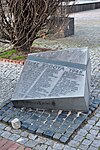The Warsaw concentration camp (German: Konzentrationslager Warschau, KL Warschau; see other names) was a German concentration camp created on the order of Reichsführer-SS Heinrich Himmler on the ruins of the Warsaw Ghetto, on the base of the now nonexistent Gęsiówka prison in what is today the Warsaw neighbourhood of Muranów. It operated from July 1943 to August 1944.
KL Warschau first functioned as a camp in its own right. However, in May 1944 it became a branch of the Majdanek concentration camp. In late July 1944, due to the Red Army approaching, the Germans started to evacuate the camp. Around 4,000 inmates were forced to march on foot to Kutno, 120 km (75 mi) away; those who survived were then transported to the Dachau concentration camp. On 5 August 1944, the camp was captured by Battalion Zośka during the Warsaw Uprising, liberating 348 Jews who were still left on its premises. It was the only German camp to be liberated by anti-Nazi resistance forces rather than by Allied troops.
The Encyclopedia on Camps and Ghettos says that a total of 8,000 to 9,000 inmates were held there. Bogusław Kopka estimates that at least 7,250 of the camp's prisoners, all but 300 of whom were Jews from various European countries who were used as forced labour to clean the ruins of the Warsaw Ghetto and to find and sort whatever precious items were still left on its territory, with the ultimate goal of creating a park in the former ghetto's area. The camp and adjacent ruins were also used by the German administration as a place of execution, where Polish political prisoners, Jews caught on the "Aryan side", and persons rounded up on Warsaw streets were killed. About 4,000 to 5,000 prisoners died during the camp's existence, while the total number of deaths attributable to the camp's activity is estimated at 20,000.The camp, which played a minor role in the Holocaust and thus seldom appears in mainstream historiography, has been at the centre of a conspiracy theory, first promoted by Maria Trzcińska, a Polish judge who served for 22 years as a member of the Chief Commission for the Prosecution of Crimes against the Polish Nation. The theory, refuted by mainstream historians, contends that KL Warschau was an extermination camp which operated a giant gas chamber inside a tunnel near Warszawa Zachodnia railroad station and that 200,000 mainly non-Jewish Poles were gassed there.After the Nazis were expelled from Warsaw by the Red Army, the new communist administration continued to run the buildings as a forced-labour camp, and then as a prison, until it was closed in 1956. All the camp's premises were demolished in 1965.












